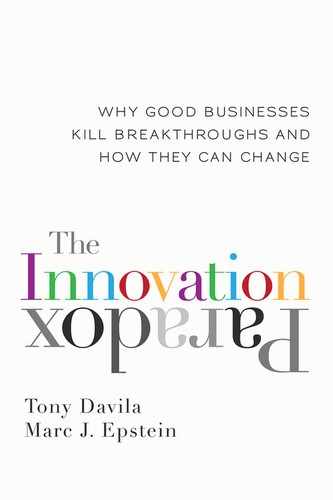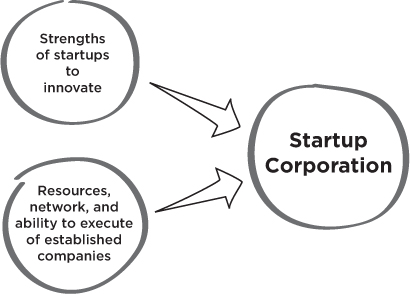10. Wrapping Up
MANY ESTABLISHED COMPANIES have a unique combination of access to networks, global presence, knowledge, resources, and management expertise that makes them well positioned to address the complex challenges that our societies face. Making progress toward solutions to these issues will require breakthrough thinking. Simply extrapolating our current business and social models will be far from enough. Yet the coming of age at roughly the same time of two trends—the emergence of a huge technological shift and the rise of venture capital funding—has created the myth that established companies cannot bring breakthrough innovations to market. Although this myth holds true for many companies, others have proven it wrong.
The innovation paradox reflects how a narrow understanding of innovation has led many established players to believe in this myth—which has become a self-fulfilling prophecy. Over the decades the relentless focus on efficiency, execution, and shortterm financial goals has reinforced the business unit as the preferred organizational structure. The business unit has proven to be the most effective management approach to deliver on these dimensions. As we have said before, it is hard to argue against efficiency, quality, and flexibility.
Of course, business units are innovative; they need to be to remain competitive. But the innovation they support is largely incremental, advancing existing technologies and business models in an effort to gain a lead over competitors. As companies rightly push the business-unit management model and believe that they are creative because they bring incremental ideas forward, they are at the same time often blocking themselves from the possibility of breakthrough innovation.
Breakthrough innovation works with a different management model than does the traditional business unit. Rather than valuing efficiency and short-term financial goals, it encourages discovery and vision. It does not call for planning in the traditional sense, but it emphasizes searching across diverse environments, and it encourages experimentation in both technology and business models. These objectives are at odds with those that make business units and incremental innovation successful, and the frustration of established companies to come up with breakthroughs is the result of this tension. Business units innovate, and business units want breakthroughs, but their processes are designed to deliver incremental innovation.
Some innovative companies are led by charismatic and visionary CEOs. While visionary CEOs have dramatically different views of the future than most, they still need organizations that execute them well. These organizations share many characteristics of the business unit. However, despite such leaders, bottom-up breakthrough innovation is often blocked.
The drawback of top-down breakthrough innovation—what we’ve called strategic bets—is that visionary business leaders seldom succeed several times. If the first vision is right, but the second vision is wrong, the management model can drive the company against a brick wall, leaving little room for dissension within the company. Of course, there are exceptions, and some entrepreneurs have scored wins more than once. But frequently the success of the first breakthrough is unrelated to the quality of the second.
Figure 10.1. The Startup Corporation
Strategic discoveries, however, are bottom-up breakthrough innovations. They involve tapping the brainpower within the company and its networks to allow breakthroughs to bubble up. Strategic discoveries require a different management approach from that of the business unit—an approach embodied in the Startup Corporation. While this management structure is inspired by the stages of innovation that startups follow, it leverages the strengths associated with being part of an established company (figure 10.1).
Strategic discoveries will rarely beat startups at what they do best: creating breakthroughs in specific products and services. Established companies generally do not have startups’ speed, and they are not exposed to market forces in the way startups are. Strategic discoveries will not beat science in coming up with breakthrough technologies, either. However, strategic discoveries excel at fostering breakthrough innovations that involve complex combinations of technologies, markets, and networks—innovations at the system level rather than the product or service level. Obviously, such discoveries also need productand servicelevel innovations, but as part of a more complicated attempt at redefining industries or creating new ones.
Strategic discoveries simply do not happen within business units. Strategic discoveries need to be managed, and the Startup Corporation is the management model for nurturing them. Because the Startup Corporation is situated within an established company, the soft and hard foundations of the company are paramount. A perfectly designed Startup Corporation model will still fail if its surrounding culture provides no incentives for risk taking (figure 10.2).
The successful implementation of the Startup Corporation model combines insights from startups with the advantages of being part of an established company. Startups are founded on the following principles: be exposed to different environments; copy and combine to learn and invent; migrate ideas to new contexts; link people and ideas; communicate and share; take risks; play with new combinations; and leverage your networks. Because moving from a seed idea into a fully scalable business requires discovering the many aspects that will finally shape the business, activities leading to successful startups are not sequential. Rather, startups go back and forth as they experiment and craft their business model. Market forces dominate most of these activities, and the local market determines the level of stimulation for ideas.
Figure 10.2. Designing for breakthrough innovation
In designing the Startup Corporation, established companies need to consider how they will manage the process of innovation. How will they inspire their people and people in their networks to come up with breakthrough ideas? Because of the importance of ecosystems for strategic discoveries, the Startup Corporation model utilizes tools—from collaboration with research institutions to startup acquisition—to attract contributors to the breakthrough. Both the stages of innovation and the design of the Startup Corporations substantially replicate market forces.
Ultimately the strength of established companies is their excellence at managing complexity. Combining different ideas, resources, and external and internal players builds on this management ability. Different solutions mix resources in various ways. Experiments test these solutions to learn which model will be best suited for getting the innovation to market. Figure 10.3 illustrates the activities that need to be managed to get breakthrough innovation.
Initial releases to market often need refinement, but incremental innovation is the strength of business units. At this point, the Startup Corporation leverages the rest of the company to move quickly through the cycles of incremental innovation and grow the market. When the innovation is mature enough that keeping ahead of competitors requires the business units’ skills—execution and incremental innovation—the final stage has come.
Figure 10.3. Managing strategic discoveries with the Startup Corporation
Various organizational designs and tools address each of these activities. Every alternative relies on market and organizational forces in different ways, and a well-designed Startup Corporation will incorporate these options according to its own situation: its size, its internal strengths and weaknesses, and its industry. In developing breakthroughs, often the main weakness is to fail at managing the entire innovation process. Companies devote many resources and much attention to the early stages—the more visible, inspirational, and spectacular ones—but they frequently fail to follow up. They fall into the Xerox PARC trap, in which they originate great ideas that end up with somebody else. Other organizations avoid the expenses necessary to foster real breakthroughs and find themselves incrementally innovating for vanishing markets, while still others have ideas that they simply can’t bring to market. This is the innovation paradox at work, and the Startup Corporation is best suited to respond to its challenge.
Governments can shape an environment that nurtures or inhibits innovation, but they do not make innovation happen. Research centers will remain at the forefront of technology and science, but their breakthroughs still need to be brought to the market. Startups will continue to surprise us with amazing breakthrough products and services, but managing the complexity of combining multiple sources of innovation, channeling the geniuses in organizations and society toward a better world, and doing it all to scale within established companies is the job of the Startup Corporation.



